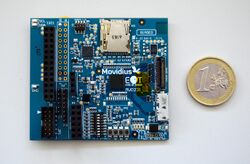Eyes of Things
From HandWiki
Revision as of 23:44, 16 November 2021 by imported>MedAI (url)
| Information | |
|---|---|
| Funding agency | European Commission |
| Framework Programme | Horizon 2020 |
| Project type | Innovation Action |
| Participants | University of Castilla–La Mancha, AWAIBA, Movidius, THALES, DFKI, Fluxguide, Evercam, nVISO |
| Start | January 2015 |
| End | June 2018 |
| Website | http://eyesofthings.eu |
Eyes of Things (EoT) is the name of a project funded by the European Union’s Horizon 2020 Research and Innovation Programme under grant agreement number 643924.[1][2][3][4][5][6][7] The purpose of the project, which is funded under the Smart Cyber-physical systems topic,[8] is to develop a generic hardware-software platform for embedded, efficient (i.e. battery-operated, wearable, mobile), computer vision, including deep learning inference.
On November 29, 2018, the European Space Agency announced that it was testing the suitability of the device for space applications in advance of a flight in a Cubesat.[9]
Motivation
EoT is based on the following tenets:[10]
- Future embedded systems will have more intelligence and cognitive functionality. Vision is paramount to such intelligent capacity
- Unlike other sensors, vision requires intensive processing. Power consumption must be optimized if vision is to be used in mobile and wearable applications
- Cloud processing of edge-captured images is not sustainable. The sheer amount of visual data generated cannot be transferred to the cloud. Bandwidth is not sufficient and cloud servers cannot cope with it.
Partners
- VISILAB group at University of Castilla–La Mancha (Coordinator)
- Movidius
- Awaiba
- Thales Security Solutions & Systems
- DFKI
- Fluxguide
- Evercam
- nVISO
Awards
- 2019 Electronic Component and Systems Innovation Award by the European Commission
- 2018 HiPEAC Tech Transfer Award
- 2018 EC Innovation Radar - highlighting excellent innovations Award
- 2018 Internet of Things (IoT) Technology Research Award Pilot by Google
- 2016 Semifinalist "THE VISION SHOW STARTUP COMPETITION", Global Association for Vision Information, Boston US
See also
- Wearable camera
- Computer vision
- Internet of Things
- Embedded systems
- Edge computing
References
- ↑ Deniz, Oscar; Vallez, Noelia; Espinosa-Aranda, Jose L.; Rico-Saavedra, Jose M.; Parra-Patino, Javier; Bueno, Gloria; Moloney, David; Dehghani, Alireza et al. (21 May 2017). "Eyes of Things". Sensors 17 (5): 1173. doi:10.3390/s17051173. PMID 28531141. Bibcode: 2017Senso..17.1173D.
- ↑ "Smart doll fitted with AI chip can read your child's emotions". https://www.newscientist.com/article/2137835-smart-doll-fitted-with-ai-chip-can-read-your-childs-emotions/.
- ↑ Emotion-reading doll is a somewhat creepy example of what´s possible with AI, by Luke Dormehl, Digital Trends, June 22, 2017
- ↑ Low-Cost Visually Intelligent Robots with EoT, D. Moloney, D. Pena, A. Dunne et al. Workshop Robotics: Science and Systems (RSS 2016), Michigan (USA) [1]
- ↑ Kick off of new 'Eyes of Things' project. CORDIS Wire
- ↑ Computer vision platform being developed by European Commission
- ↑ HiPEAC members will coordinate a European project on Smart Cyber-Physical Systems, HiPEAC Info n. 41, page 12, January 2015, [2][yes|permanent dead link|dead link}}]
- ↑ "ICT 2014 - Information and Communications Technologies, Topic: Smart CyberPhysical Systems". http://ec.europa.eu/research/participants/portal/desktop/en/opportunities/h2020/topics/78-ict-01-2014.html.
- ↑ ESA (2018-12-04). "ESA team blasts Intel's new AI chip with radiation at CERN" (in en-GB). https://www.esa.int/Our_Activities/Space_Engineering_Technology/ESA_team_blasts_Intel_s_new_AI_chip_with_radiation_at_CERN.
- ↑ A Vision for the Future. D. Moloney, O. Deniz. IEEE Consumer Electronics 4(2), April 2015, [3]
 |


